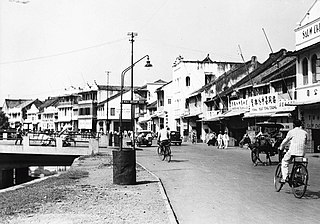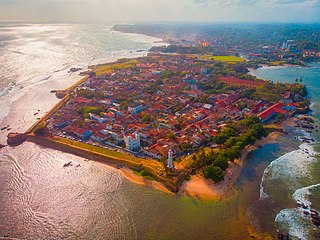Related Research Articles
The known and sometimes formally documented history of Mauritius begins with its possible discovery by Austronesians under the Austronesian expansion from pre-Han Taiwan, circa 1500 to 1000 BCE, and then by Arabs,, followed by Portuguese and its appearance on European maps in the early 16th century. Mauritius was successively colonized by the Netherlands, France and Great Britain, and became independent on 12 March 1968.

Port Louis is the capital city of Mauritius. It is mainly located in the Port Louis District, with a small western part in the Black River District. Port Louis is the country's financial and political centre, and the most populous city. It is administered by the Municipal City Council of Port Louis. According to the 2018 census conducted by Statistics Mauritius, the population was 147,066.

Batavia was the capital of the Dutch East Indies. The area corresponds to present-day Jakarta, Indonesia. Batavia can refer to the city proper or its suburbs and hinterland, the Ommelanden, which included the much larger area of the Residency of Batavia in the present-day Indonesian provinces of Jakarta, Banten and West Java.

Grand Port is a district of Mauritius, situated in the east of the island. The name means "large port" in French. The district has an area of 260.3 km2 and the population estimate was at 112,997 as of 31 December 2015.

Oranjestad is a small town of 1,038 inhabitants; it is the capital and largest town of the island of Sint Eustatius in the Caribbean Netherlands. It’s not to be confused with the far larger Oranjestad in Aruba.

Mahébourg is a small town on the south-eastern coast of the island of Mauritius, having a population of 15,457 as of 2015. It is considered the main town of the Grand Port District.

Old Banten is an archaeological site in the northern coast of Serang Regency, Banten, Indonesia. Located 11 km north of Serang city, the site of Old Banten contains the ruin of the walled port city of Banten, the 16th-century capital of the Sultanate of Banten.
Sookdeo Bissoondoyal was a Mauritian politician and one of the leading figures in the independence movement.

Blaye is a commune and subprefecture in the Gironde department in Nouvelle-Aquitaine in southwestern France. For centuries, Blaye was a particularly convenient crossing point for those who came from the north and went to Bordeaux or further south, to Spain and Portugal. Fortified since antiquity, this eminently strategic site located on the bank of a large river, was modernized at the end of the 17th century, thanks to Vauban. In 1685, the Commissaire general des fortifications of Louis XIV proposed the construction of a real lock on the Gironde in order to "take control of the river" and to hold Bordeaux in case of a revolt. It is then that the citadel of Blaye was built, constituting the major element of the estuary control system. Dominating the urban landscape, this imposing building has been listed as a UNESCO World Heritage Site since 2008, as part of a group of structures engineered by Vauban, in testimony to their global influence on military architecture and planning over the next few centuries.
Reinier or Reiner Por was the Dutch opperhoofd or governor of Mauritius from 1648 to 1653. Five years after his death the first Dutch colony was briefly abandoned, to be re-established at the same location in Grand Port in 1666.

Hubert Hugo served as a merchant for the Dutch East India Company (VOC) from 1640 to 1654 in Gujarat. He later turned to privateering or piracy in the Arabian Sea and the Gulf of Aden around 1662. In 1664, he was acquitted by the States of Holland and returned to the service of the VOC. He served as commander of Mauritius until 1677. In 1674 he became one of the last people to document the presence of the dodo on Mauritius.

Bheemunipatnam, is a suburb of Visakhapatnam, India. The town was named after Bhima, a character in the Hindu epic Mahabharata. It formerly administered under the Bheemunipatnam municipality, but merged into GVMC in 2017. It is currently under the administration of Bheemunipatnam revenue division and the headquarters is located at Bheemunipatnam.

The Lukut Fort and Museum is a historical site in Port Dickson, Negeri Sembilan, Malaysia. The fort was built by Raja Jumaat in 1847 and later controlled by his son Raja Bot. Located on a hill, it is in ruins and the area has been converted into a historic recreation park above the museum. The museum houses some of the antiquities of the fort, apart from artefacts and pictures related to the history of the past tin extraction done in Lukut area.

The Old Port of Marseille is at the end of the Canebière, the major street of Marseille. It has been the natural harbour of the city since antiquity and is now the main popular place in Marseille. It became mainly pedestrian in 2013.

Galle Fort, in the Bay of Galle on the southwest coast of Sri Lanka, was built first in 1588 by the Portuguese, then extensively fortified by the Dutch during the 17th century from 1649 onwards. It is a historical, archaeological and architectural heritage monument, which even after more than 432 years maintains a polished appearance, due to extensive reconstruction work done by Archaeological Department of Sri Lanka.

Mauritius was an official settlement of the Dutch East India Company on the island of Mauritius between 1638 and 1710, and used as a refreshing station for passing ships. It was already frequented by Dutch ships from 1598 onwards, but only settled in 1638, to prevent the French and the British from settling on the island.

The Citadel Prins Frederik, also called Fort Prins Frederik, was a fortification built in 1837 by the Dutch in Batavia, in the Dutch East Indies. It was located at Wilhelmina Park, which demolished around 1961 and replaced by the Istiqlal Mosque.

Mauritius is a religiously diverse nation, with Hinduism being the most widely professed faith. According to the 2011 census made by Statistics Mauritius, Hinduism is the major religion at 48.54%, followed by Christianity at 32.71%, followed by Islam 17.30% and Buddhism 0.18% in terms of number of adherents.
The following is a timeline of the history of the city of Port Louis on the island of Mauritius.
References
- ↑ "About The Museum – Mauritius Museums Council" . Retrieved 1 March 2022.